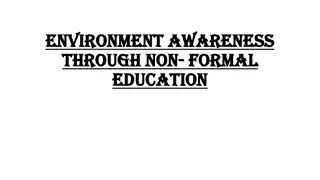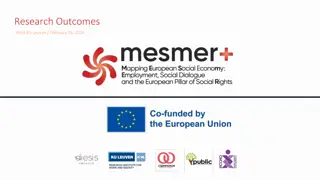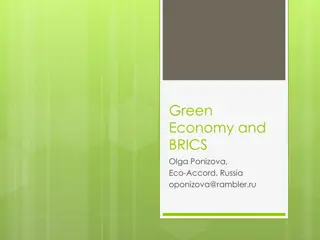Understanding the Transition to Formal Economy: Concepts and Recommendations
The concept of the informal economy, formal arrangements, and the distinction between informal sector and informal employment are explained in detail. Recommendations and resolutions from ILO concerning the transition from informal to formal economy, statistical guidelines, and definitions are highlighted to provide insights into addressing the challenges of informal economic activities.
Download Presentation

Please find below an Image/Link to download the presentation.
The content on the website is provided AS IS for your information and personal use only. It may not be sold, licensed, or shared on other websites without obtaining consent from the author. Download presentation by click this link. If you encounter any issues during the download, it is possible that the publisher has removed the file from their server.
E N D
Presentation Transcript
Conceptual framework Recommendation concerning the transition from the informal to the formal economy (ILC R204, 2015) Resolution concerning statistics of work, employment and labour underutilization (19th ICLS, 2013) Work Measuring informality: A statistical manual on the informal sector and informal employment (ILO, 2013) Resolution concerning statistics of the economically active population(13th ICLS, Resolution concerning statistics of the economically active population(13th ICLS, 1982) 1982) Employment Guidelines concerning a statistical definition of informal employment (17th ICLS, 2003) Resolution concerning statistics of employment in the informal sector (15th ICLS, 1993) (Employment in) Informal sector Informal employment 2
The concept of informal economy Recommendation 204 provides a definition: the term informal economy refers to all economic activities by workers and economic units that are in law or in practice not covered or insufficiently covered by formal arrangements 2(a) Economic units in the informal economy Those not covered or insufficiently covered by formal arrangements Workers in the informal economy 3
Formal arrangements Procedures established by the government To regulate the actions and functions of economic units To recognise the economic units and protect their legal rights To carry out economic activities, to engage in commercial contracts, to safeguard their intellectual and physical property, etc. Procedures to report economic activities, employees In order to pay taxes (on production, on sales) In order to cover employees for social security, etc. 4
Informal economy Two components (2 statistical units): Informal sector (enterprise based concept) 15 th ICLS Informal employment (worker / job based concept) 17 th ICLS Informal employment Informal sector Two different aspects of informal economy Important to keep separate as often require different policies Important to understand the relation between them 5
Informal sector Image result for Informal sector
Billedresultat for measuring giraffe Informal sector is like a giraffe difficult to define by usual standards, but easy to recognise when you meet one Hans Singer Informal sector is not so much defined by what it is rather by an absence of characteristics
Why work in the informal sector Survival strategies, due to lack of (adequate) jobs A wish for independency and flexible work arrangements More profitable then working in the formal sector The continuation of traditional activities Avoiding regulations and so on .
Many faces Large diversity Different between different regions, countries and areas within the same country, Urban/Rural Different industries, activities, different types of enterprise Informal activities range from street vendors, shoe shining and other minor activities requiring little or no capital and skills To manufacturing, tailoring, car repair demanding more skills and capital and with higher productivity. Informal sector do not equal illegal work
Concept of Informal sector 15 th ICLS Market oriented The informal sector may be broadly characterised as consisting of units engaged in the production of goods or services with the primary objective of generating employment and incomes to the persons concerned Low level of organisation These units typically operate at a low level of organisation, with little or no division between labour and capital as factors of production and on a small scale
Informal sector Statistical definition I Based on SNA household sector Economic units in the household sector : I. Are not constituted as separate legal entities (are owned by persons/households) II. Do not have complete accounts (i.e., excludes quasi-corporations) Can produce goods and services for sale or barter Can produce goods and services exclusively for own final use Including households that employ paid domestic employees
Informal sector Statistical definition II Adding a criteria of producing at least something for the market Excluding Own use production exclusively for own final use Household market units
Informal sector Statistical definition III Housholdemarket units: I. Are not constituted as separate legal entities (are owned by persons/households) II. Do not have complete accounts (i.e., excludes quasi-corporations) III. Do produce goods and services for sale or barter
Statistical definition IV Additional criteria's for operational purposes, depending on the national context Household market units can be divided in two sub- categories No employees (Own account enterprises) Either all own-account workers or Only those which are not registered under specific forms of national legislation With employees (Enterprises of employers) size of the unit below a specified level of employment or/and only those which are not registered under specific forms of national legislation or/and Only those that have registered (some of) their employees
Institutional units of the System of National Accounts Institutional sectors Corporations Government units Non-profit institutions Households Non-market household units Institutional households, households with no unincorporated enterprises, households only undertaking production for own final use Market household units Unincorporated enterprises owned by households Quasi-corporations Corporations (Complete set of account) (Seperate legal unit) (i) Not incorporated (ii) No complete set of accounts (iii) Market production 15
Institutional units of the System of National Accounts For operational purposes, depending on the national context Market household units Unincorporated enterprises owned by households Owned by own- account workers Owned by employers Informal sector Formal sector Informal sector Formal sector (i) Enterprise registration (under specific forms of national legislation (ii) all (i) (ii) Establishment size (iii) Employee registration Enterprise registration 16
Market production Units that produce at least some goods or services for sale Recognises that informal sector seeks to generate income Excludes production solely for own final use Operationalization: Is typically covered initially, when identifying employment Might not be relevant in countries with a insignificant share of own use production work
Unincorporated Units are not a separate legal entity Recognise that the owners are persons or households and not legal persons Excludes: Governments Corporations Non-profit organisations Operationalization : Part of defining institutional sector (or a direct question) Need to use national expressions for an incorporated enterprise e.g. limited company, trading partnership, limited partnership
No bookkeeping To exclude economic units that keep formal accounts required by law (Quasi-corporations) It is not possible to separate between the economy of the economic unit and the household Operationalization : Find out what are the requirements in your country Be as precise as possible Just keeping books for own use does not qualify 19
No registration To exclude economic units that conform with the legal and administrative framework in force in the country Registration at national level in order to apply to Factories / commercial acts Tax/social security laws, Professional groups regulatory acts, etc. As distinct from local regulations for issuing trade licenses or business permits Because they are governed by administrative regulations that may vary from region to region and in time Because they do not affect the way the units operate and behave Operationalization : Use national examples in the question 20
Size below x To include small units It is a proxy to low level of organisation and small scale operation Not always a good proxy as there may be small units which are registered and keep accounts Should only be used when there is no other information available The size may vary between countries and branches of economic activity Should take into account the size limits used in formal sector establishment surveys 21
Flexibility within the 15th ICLS The use of the register criteria Recommendation from ILO is to use it The use of size criteria Recommendation from ILO is to not use it For practical reason possible to only cover non- agriculture Recommendation from ILO is to cover agriculture as well Covering main jobs or all jobs From the perspective of informal sector all jobs should be covered. From the perspective of informal employment, might be sufficient with main job and second job if possible.
Example: combining the criteria ( 6, Resolution concerning statistics of employment in the informal sector, 15th ICLS) The economic unit is incorporated No Yes Government, corporations, non-profit institutions (SNA) Household economic unit (SNA) The economic unit keeps required accounts Yes No Market household economic unit (SNA) Quasi- corporation (SNA) The economic unit produces goods or services for sale No No Yes The The economic unit is a household producing exclusively for own final use Yes economic unit is registered The economic unit is in the informal sector The economic unit is in the formal sector 23
Employment in the informal sector Employment in the informal sector = All persons employed in the informal sector OR All persons working in the informal sector
Minimum set of data items that needs to be collected Number of economic units that are in the informal sector (informal sector units) Production, value added (Input to SNA) Number of informal sector entrepreneurs Number of workers and jobs in the informal sector All data items should be cross-classified by relevant variables 25























